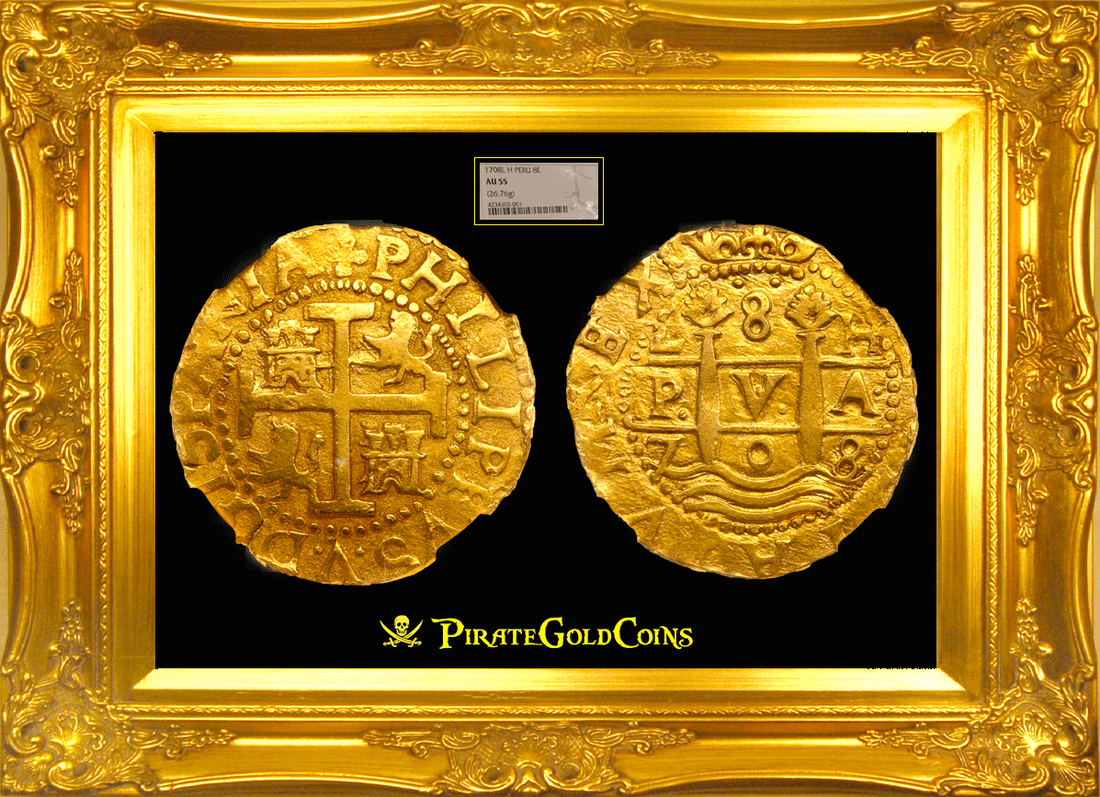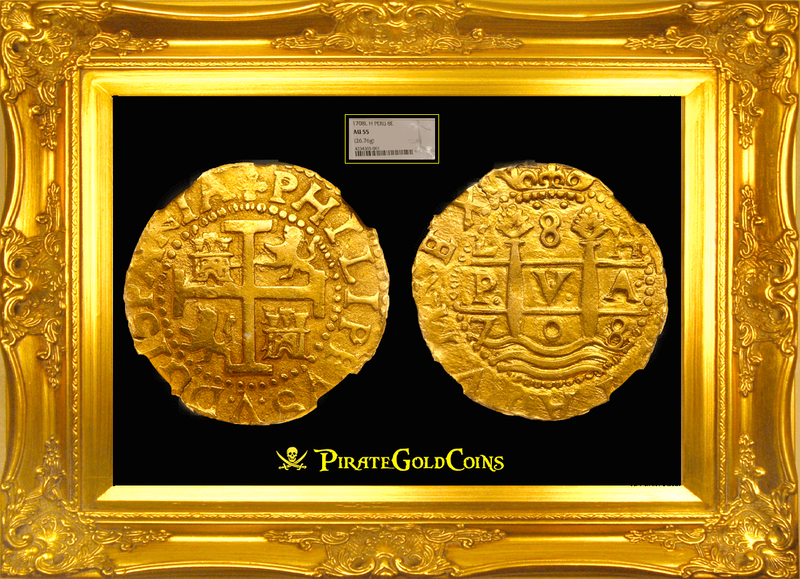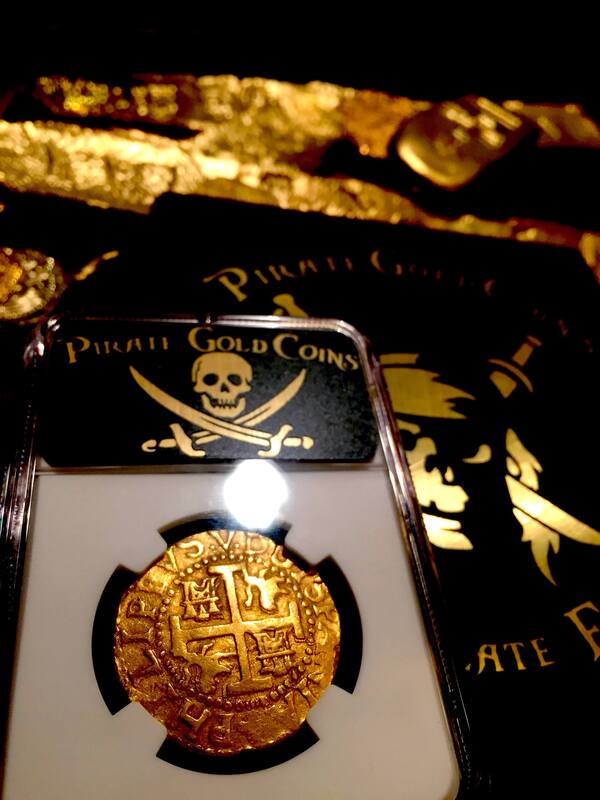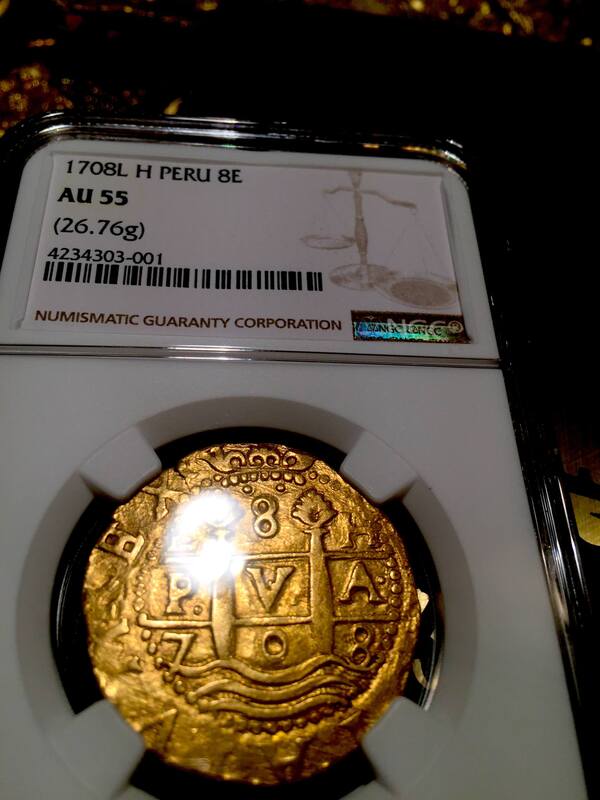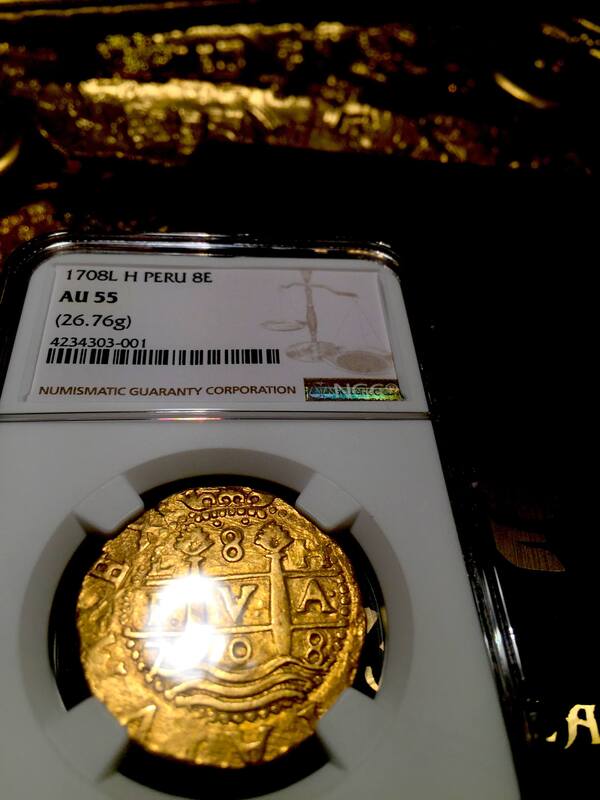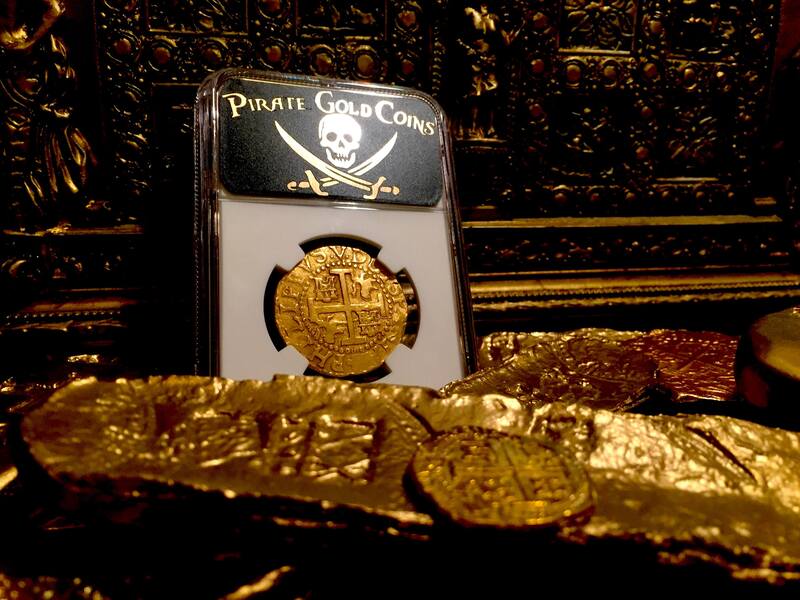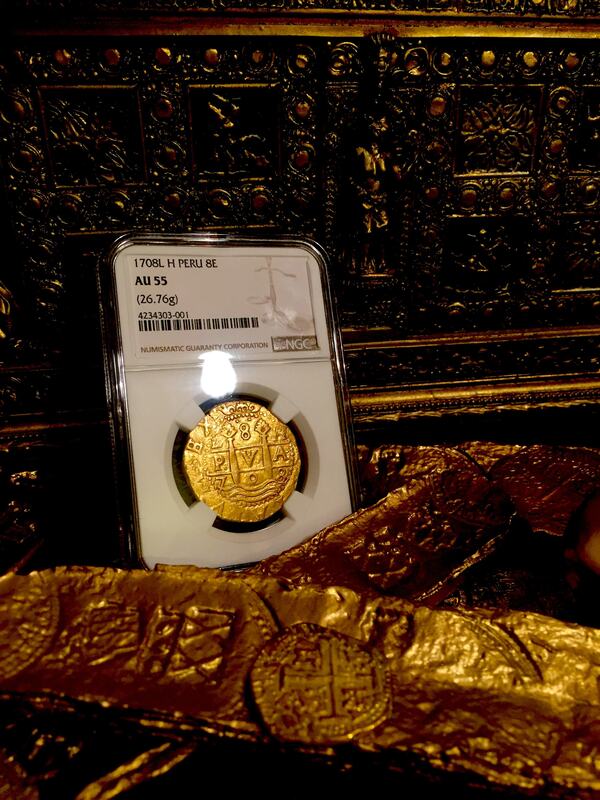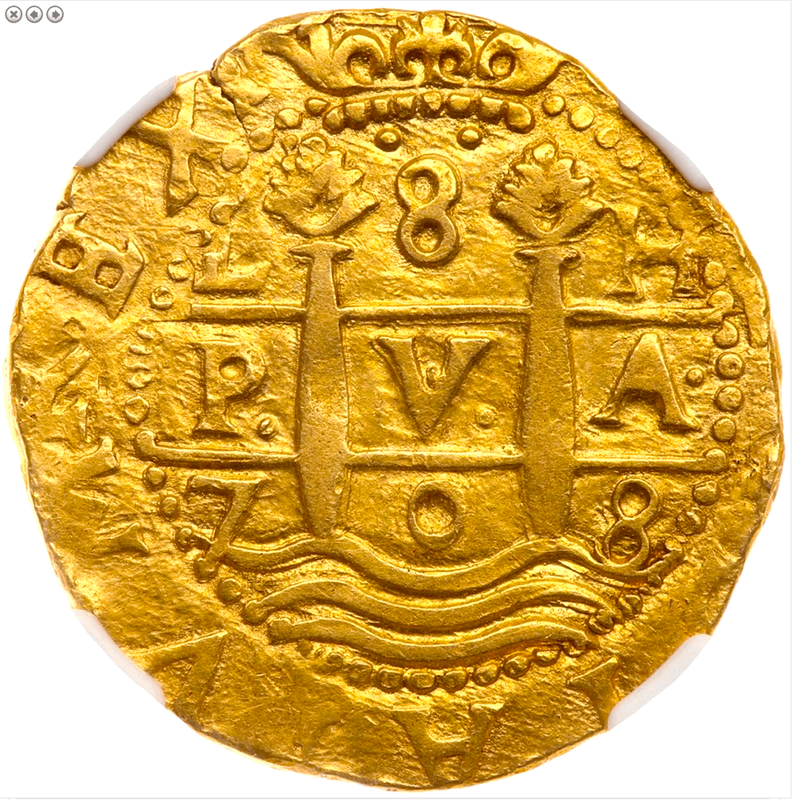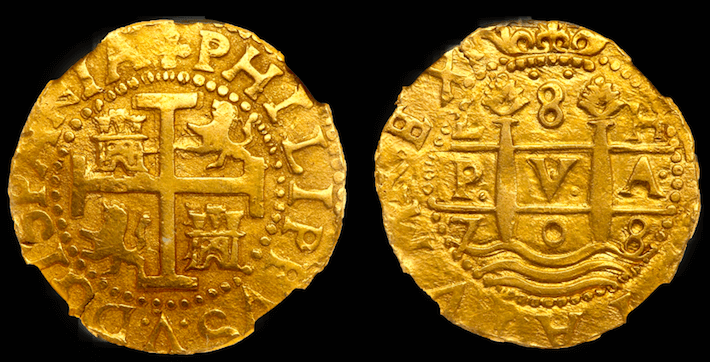PERU 1708L-M 8 ESCUDOS "1715 PLATE FLEET SHIPWRECK" DOUBLE DATE GOLD DOUBLOON COIN ~ NGC 55 ~
THIS BEAUTIFUL GOLD “PIECES OF EIGHT” HAS HAD A 300 YEAR JOURNEY! STRUCK ON A VERY LARGE PLANCHET, MAKING ROOM FOR ALMOST COMPLETE LEGENDS ON BOTH OBVERSE & REVERSE. THE STRIKE IS IS INCREDIBLE AND CERTAINLY REFLECTS IT'S SHIPWRECK HISTORY, DISPLAYING ENCRUSTRATIONS THROUGHOUT THE DOUBLOON~REFLECTING IT'S TIME IN THE OCEANS DEPTHS., A VERY DEEP AND BOLD STRIKE INDEED AND ABSENT OF ALMOST ANY DOUBLING! THE CROSS SIDE HAS THE SAME DEEP STRIKE, EVEN THE CASTLES DISPLAY EACH WINDOW AND THE COMPLETE KING’’S NAME IS INTACT (RARELY EVER SEEN). THE LUSTER ON THIS GOLD DOUBLOON IS WHAT SPEAKS TO ME THE MOST, JUST A STUNNING PIECE! WEIGHING IN AT A FULL WEIGHT OF 26.9grams. ASSAYER ~ H (HURTADO).
From the 1715 PLATE FLEET ~ this piece is consistent with all the other Uncirculated high quality pieces, which were salvaged by the Real 8 co. from the Douglas Beach site (Nieves), testifying to its Fleet origins. Most of the 1712’s (&11’s) were originally sold in the Real 8 auctions between 1964-1977.
The Nuesta Senora de las Nieves y las Aminas (under Captain- General Ubilla and captained by Francisco de Soto Sanchez (who actually owned this vessel, built in Portugal, coming in only at 192.5 tons with a dozen cannons wrecked at Frederick Douglas Park (Douglas Beach). The Nieves’ manifest registered 44,000 pesos of GOLD on board. This wreck site was NOT worked by Spanish salvors of the day, who concentrated their efforts on the larger vessels for the next four yrs. This galleon had vast amounts of contraband and modern day salvagers brought up gold and silver bars “without tax stamps,” as well as emerald studded rings and jewelry. Indeed, this is the site where Bob Weller brought up the famed “golden rosary” with a 6’ chain.
Clearly displayed on this piece, are very strong and bold strikes, as well as on both legends and devices. There’s very minor doubling on the cross and displays a good portion of the Crown as well.
The 1712 was the 2nd year behind the inaugural 1710’s to strike a “Double date” in the legends. In 1710 (first year of Double dating), assayer Hurtado was in his final year. Assayer Melgarejo “M” was appointed in 1711, still a mystery to date, he ceased the “Double Date” practice; but resumed it again in 1712. Fortunately for modern salvaging, for over 50 years on the 1715 wreck sites, most dates are obtainable; prior to this, the 1708 – 1714 dates were rare to extremely rare.
(GO TO BOTTOM OF PG TO READ ABOUT 1715 PLATE FLEET SHIPWRECK)
From the 1715 PLATE FLEET ~ this piece is consistent with all the other Uncirculated high quality pieces, which were salvaged by the Real 8 co. from the Douglas Beach site (Nieves), testifying to its Fleet origins. Most of the 1712’s (&11’s) were originally sold in the Real 8 auctions between 1964-1977.
The Nuesta Senora de las Nieves y las Aminas (under Captain- General Ubilla and captained by Francisco de Soto Sanchez (who actually owned this vessel, built in Portugal, coming in only at 192.5 tons with a dozen cannons wrecked at Frederick Douglas Park (Douglas Beach). The Nieves’ manifest registered 44,000 pesos of GOLD on board. This wreck site was NOT worked by Spanish salvors of the day, who concentrated their efforts on the larger vessels for the next four yrs. This galleon had vast amounts of contraband and modern day salvagers brought up gold and silver bars “without tax stamps,” as well as emerald studded rings and jewelry. Indeed, this is the site where Bob Weller brought up the famed “golden rosary” with a 6’ chain.
Clearly displayed on this piece, are very strong and bold strikes, as well as on both legends and devices. There’s very minor doubling on the cross and displays a good portion of the Crown as well.
The 1712 was the 2nd year behind the inaugural 1710’s to strike a “Double date” in the legends. In 1710 (first year of Double dating), assayer Hurtado was in his final year. Assayer Melgarejo “M” was appointed in 1711, still a mystery to date, he ceased the “Double Date” practice; but resumed it again in 1712. Fortunately for modern salvaging, for over 50 years on the 1715 wreck sites, most dates are obtainable; prior to this, the 1708 – 1714 dates were rare to extremely rare.
(GO TO BOTTOM OF PG TO READ ABOUT 1715 PLATE FLEET SHIPWRECK)
The 1715 Treasure Fleet was a Spanish treasure fleet returning from the New World to Spain. In the evening of July 30, 1715 , seven days after departing from Havana, Cuba, 11 of the 12 ships of this fleet were lost in a hurricane near present day Vero Beach, Florida. Because the fleet was carrying silver, it is also known as the 1715 Plate Fleet (plata being the Spanish word for silver plate). Some artifacts and even coins still wash up on Florida beaches from time to time.
Around 1,000 sailors perished while a small number survived on lifeboats. Many ships, including pirates, took part in the initial salvage. Initially a privateer, Henry Jennings was first accused of piracy for attacking such salvage ships and claiming their salvages. Thus, earning this coinage the name of “Pirate’s Gold!”
The story begins with the “War of the Spanish Succession” ending, as well as the death of the Spanish Queen. King Philip found a new bride, Elizabeth Farnesse, Duchess of Palma and needed a new Queens Dowry. The king would send two separate fleets to the New World (after the Government had cancelled all sailings from the Americas to Spain for two years), which would load up at separate ports ~ Vera Cruz and Cartegena, then meet up in Havana. The plan was to have one large Armada with a heavy navel escort, carrying the accumulated precious metals and jewels from the last three years. Of which, the average year sailed in between 90 and 120 million francs.
Treasure ~ The Cartegena Fleet arrived first in Havana (in March), loaded down by chests filled with Gold coins (from Santa Fe de Bogota), Colombian Emeralds from Muzo mine and gold jewelry from Peru. Awaiting the fleet of Vera Cruz, commanded by Gen. Don Juan Eseban de Ubilla, carrying Gold and Silver ingots. However Don Juan was delayed in Vera Cruz awaiting pack mule trains from Acapulco. Finally in the first week of May the mule train arrived with their silks, ivories and blue and white porcelains. The details of the Queens jewels are blurry at best, but were known to include and Emerald ring weighing in at 74 carats, a heart designed from 130 matched pears, a pair of earrings each of 14 pears and a rosary of pure coral. There were 8 chests in total and stowed in Ubilla’s cabin (who was a senior military officer and had overall command).
After many other delays, finally the Galleons left Havana on Wednesday July 24th, with favorable winds pushing them at nearly 6 knots. By the 29th the winds were over 70 knots, with gusts hitting over 100 knots. The chaplain said, “the water flew in the air like arrows, doing injury to those it hit.” Finally, at 2:30am on July 31st, the flagship hit the reefs and torn apart, throwing all off her decks and 223 sailors were pounded to death by the rocks. More than 700 men were missing, wreckage and bodies scattered for almost 30 miles along the coast.
For the next four years the Spanish attempted to salvage the treasure, but finally ceased in 1719. The dangers or sharks, pirates and Indians were just too great. Records show approx.. 30% of the inventoried treasure was recovered, which is a low estimate due to much of the inventory being kept off the books to avoid the king’s tax. There was an estimate of 14 million pesos registered treasure lost.
This sunken fleet of Galleons is still giving up her Treasure! In 2010 the claim owners discovered the only bronze swivel gun ever found on the 1715 Fleet. Tucked away inside this the bronze cannon were 51 Gold Escudos and 40 Silver Reales. Shortly after was another discovery of the most amazing artifact, the “Pelican in Piety,” worth $885,000. Then in July 2014, the claim owners crew recovered another 51 Gold escudos valued at $300,000. Most recently, another find of 50 Feet of Gold Chain and 5 additional Gold escudos were just recovered, approx.. $300,000 in value.
Around 1,000 sailors perished while a small number survived on lifeboats. Many ships, including pirates, took part in the initial salvage. Initially a privateer, Henry Jennings was first accused of piracy for attacking such salvage ships and claiming their salvages. Thus, earning this coinage the name of “Pirate’s Gold!”
The story begins with the “War of the Spanish Succession” ending, as well as the death of the Spanish Queen. King Philip found a new bride, Elizabeth Farnesse, Duchess of Palma and needed a new Queens Dowry. The king would send two separate fleets to the New World (after the Government had cancelled all sailings from the Americas to Spain for two years), which would load up at separate ports ~ Vera Cruz and Cartegena, then meet up in Havana. The plan was to have one large Armada with a heavy navel escort, carrying the accumulated precious metals and jewels from the last three years. Of which, the average year sailed in between 90 and 120 million francs.
Treasure ~ The Cartegena Fleet arrived first in Havana (in March), loaded down by chests filled with Gold coins (from Santa Fe de Bogota), Colombian Emeralds from Muzo mine and gold jewelry from Peru. Awaiting the fleet of Vera Cruz, commanded by Gen. Don Juan Eseban de Ubilla, carrying Gold and Silver ingots. However Don Juan was delayed in Vera Cruz awaiting pack mule trains from Acapulco. Finally in the first week of May the mule train arrived with their silks, ivories and blue and white porcelains. The details of the Queens jewels are blurry at best, but were known to include and Emerald ring weighing in at 74 carats, a heart designed from 130 matched pears, a pair of earrings each of 14 pears and a rosary of pure coral. There were 8 chests in total and stowed in Ubilla’s cabin (who was a senior military officer and had overall command).
After many other delays, finally the Galleons left Havana on Wednesday July 24th, with favorable winds pushing them at nearly 6 knots. By the 29th the winds were over 70 knots, with gusts hitting over 100 knots. The chaplain said, “the water flew in the air like arrows, doing injury to those it hit.” Finally, at 2:30am on July 31st, the flagship hit the reefs and torn apart, throwing all off her decks and 223 sailors were pounded to death by the rocks. More than 700 men were missing, wreckage and bodies scattered for almost 30 miles along the coast.
For the next four years the Spanish attempted to salvage the treasure, but finally ceased in 1719. The dangers or sharks, pirates and Indians were just too great. Records show approx.. 30% of the inventoried treasure was recovered, which is a low estimate due to much of the inventory being kept off the books to avoid the king’s tax. There was an estimate of 14 million pesos registered treasure lost.
This sunken fleet of Galleons is still giving up her Treasure! In 2010 the claim owners discovered the only bronze swivel gun ever found on the 1715 Fleet. Tucked away inside this the bronze cannon were 51 Gold Escudos and 40 Silver Reales. Shortly after was another discovery of the most amazing artifact, the “Pelican in Piety,” worth $885,000. Then in July 2014, the claim owners crew recovered another 51 Gold escudos valued at $300,000. Most recently, another find of 50 Feet of Gold Chain and 5 additional Gold escudos were just recovered, approx.. $300,000 in value.

